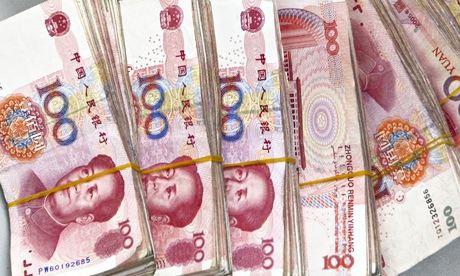Chinese yuan's decline leaves observers guessing
Currency's slide against the dollar could signal the opening of financial markets – or weakening demand and future instability

Bundles of Chinese yuan. The currency has fallen against the dollar since February. Photograph: AFP/Getty Images
Since December, when the US Federal Reserve began tapering its monthly purchases of long-term assets, emerging-market currencies have fallen across the board.
The main exception until recently was China's indomitable yuan. But now the yuan, too, has been falling against the dollar. So is this more evidence of the disruptive impact of the Fed's policy?
The yuan's decline is not large, and whether it will continue is uncertain. But the movement is striking by the standards of what is still a heavily managed currency. And it is in the opposite direction from what everyone has come to expect.
Certainly, the Fed's tapering of its quantitative-easing policy has had some effect. A standard money-making strategy for investors with access to Chinese financial markets has been to borrow dollars at low interest rates and buy high-yield Chinese assets. But tapering, by auguring higher US interest rates, makes it more expensive to borrow dollars and invest in Chinese assets. As "the carry trade" falls out of fashion, demand for the yuan declines and its exchange rate depreciates.
But, while the Fed has been tapering since December, the weakness of the yuan materialised only in February. Evidently something else is going on.
The reality is that China's tightly controlled currency falls only when the People's Bank of China wants it to fall. The PBOC, not the Fed, calls the tune to which the yuan dances.
So why has it been singing the depreciation song?
One possibility is that a weaker yuan is, paradoxically, part of the Chinese government's strategy for encouraging its wider international use. China is committed to broadening the yuan's role for foreign trade and investment-related purposes. Ultimately, it would like to see the yuan achieve an international status comparable to that of the dollar.
To do that, China will have to develop its financial markets and open them to foreign investors. But opening those markets is feasible only if the authorities eliminate the perception that exchange-rate movements are a one-way proposition. So long as investors believe that the yuan can only appreciate, opening the country's markets will cause it to be flooded by foreign money, with unpleasant financial consequences, not the least of which is inflation.
Foreign investors therefore need to be reminded that the yuan can fall as well as rise. Some observers regard the yuan's recent slide as an attempt to squeeze the speculators and signal the advent of a more flexible exchange rate. They believe that the PBOC is about to widen the currency's trading band.
If so, the PBOC's recent market moves are a good thing. If there is one clear lesson from history, it is that the combination of open financial markets and a rigid exchange rate is a disaster waiting to happen. China has already begun opening its financial markets. Thus, greater exchange-rate flexibility is overdue.
A second, less positive interpretation is that the PBOC is weakening the yuan in order to boost Chinese exports. Reacting against excesses in the country's property markets and shadow banking system, the PBOC has moved, not unreasonably, to limit the availability of cheap credit. But this may have caused domestic demand growth to slow more rapidly than expected. And boosting exports is, of course, China's customary response to weaker domestic demand.
This less encouraging interpretation of the yuan's recent weakening suggests that official efforts to clamp down on the shadow banking system are not going well, and that the effort to engineer a soft economic landing is not on course. If this view is correct, efforts to rebalance the Chinese economy could now be put on hold, which would not bode well for future economic and financial stability.
Moreover, if China is pushing down the yuan in order to goose its exports, its policy will not sit well with its foreign competitors, be they the US or Japan. Complaints about currency manipulation and the associated diplomatic tensions will quickly return.
China is sufficiently opaque that it is hard to know from the outside which interpretation is correct. Future yuan movements will tell the tale. Mainly up-and-down fluctuations would be a sign that the policymakers' goal is to eliminate one-way bets and advance the cause of yuan internationalisation. A secular decline, by contrast, would indicate that demand in China is weakening and rebalancing has been suspended.
For now, the only thing observers can do is to watch closely and hope for the best. And it is the PBOC they should be watching, not the Fed.
No comments:
Post a Comment
Comments always welcome!